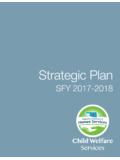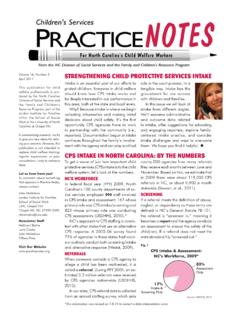Transcription of FAMILIES AT THE NEXUS OF HOUSING AND CHILD WELFARE
1 FAMILIES AT THE NEXUS OF. HOUSING AND CHILD WELFARE . Amy Dworsky, Chapin Hall at the University of Chicago November 2014. INTRODUCTION. Research on the relationship between HOUSING and CHILD WELFARE has consistently found a higher rate of CHILD WELFARE system involvement among FAMILIES that are homeless or otherwise precariously housed than among low income FAMILIES with stable Studies also show that HOUSING problems are common among CHILD WELFARE system involved FAMILIES and can become a barrier to the reunification of children who have been placed in out-of-home A growing awareness of the relationship between HOUSING and CHILD WELFARE has led to calls in recent years for interventions aimed at preventing homeless or otherwise precariously housed from entering the CHILD WELFARE system or for increased attention to the HOUSING needs of FAMILIES with current CHILD WELFARE system involvement.
2 Although some progress has been made on both these fronts, much remains to be done to avoid the unnecessary removal of children from their homes or delays in their return due to inadequate or unstable HOUSING . This issue brief summarizes what we currently know about the relationship between HOUSING and CHILD WELFARE , describes some of the ways CHILD WELFARE agencies are addressing the HOUSING needs of FAMILIES and explores the use (or potential use) of HOUSING interventions to reduce CHILD WELFARE involvement among FAMILIES that are homeless. It concludes with a discussion of implications for policy, practice and future research. WHAT DO WE KNOW ABOUT THE RELATIONSHIP BETWEEN. HOUSING AND CHILD WELFARE ? Research on the relationship between HOUSING and CHILD WELFARE has consistently found a higher rate of CHILD WELFARE system involvement among homeless FAMILIES than among low income FAMILIES that are housed.
3 Specifically, homeless FAMILIES are more likely than their non-homeless counterparts to be the focus of a CHILD protective services (CPS) investigation,3 to have an open CHILD WELFARE case,4 or to have a CHILD placed in out of home These differences seem to persist even after controlling for other factors that might be associated with an increased risk of CHILD WELFARE system To date, most studies of the relationship between HOUSING and CHILD WELFARE has focused on homeless FAMILIES that entered the shelter Non-sheltered homeless FAMILIES as well as FAMILIES that are living doubled up or are otherwise precariously housed have largely been excluded from this research. One study that did include FAMILIES with a broader range of HOUSING problem found that experiencing a HOUSING -related problem such as being evicted or living doubled up increased the risk of having an investigated report of physical Another, more recent study found that living doubled up increased the odds of having a substantiated CHILD maltreatment report, but only among FAMILIES in which the caregiver had a mental health or substance abuse Not only does the research indicate that the rate of CHILD WELFARE system involvement is higher among homeless or precariously housed FAMILIES than among FAMILIES that are demographically similar but stably housed, but also, that among FAMILIES with children in out of home care, unstable or inadequate HOUSING can delay reunification.
4 Even if HOUSING problems were not what brought those FAMILIES to the attention of CPS,10. and after controlling for other factors that may affect whether children are returned HOW PREVALENT ARE HOUSING PROBLEMS AMONG CHILD . WELFARE INVOLVED FAMILIES ? Some information on the prevalence of HOUSING problems among CHILD WELFARE system involved FAMILIES is provided by the data that states are required to submit each year to the Adoption and Foster Care Analysis and Reporting System (AFCARS). Inadequate HOUSING was identified as one of the "circumstances of removal" for approximately 11 percent of children who were in foster care in at some point in FY Unfortunately, the AFCARS data only capture HOUSING problems identified as contributing to a CHILD 's placement and do not distinguish among the different ways in which FAMILIES can be inadequately housed ( , homelessness, overcrowding, unsafe conditions).
5 Other data come from studies of FAMILIES receiving CHILD WELFARE services. One of these studies found that HOUSING problems, including eviction, doubling up and homelessness, were more common among FAMILIES with children in out-of-home care than among FAMILIES receiving voluntary intensive in-home services However, FAMILIES were more likely than their caseworkers to identify needing help with HOUSING whereas caseworkers were more likely to identify needs related to parent FAMILIES at the NEXUS of HOUSING and CHILD WELFARE | State Policy Advocacy and Reform Center 2. WHAT EXPLAINS THE HIGH RATE OF CHILD WELFARE SYSTEM. INVOLVEMENT AMONG HOMELESS AND OTHERWISE. PRECARIOUSLY HOUSED FAMILIES ? In some cases, FAMILIES come to the attention of CHILD protective services because their homelessness or substandard HOUSING conditions ( , excessive heat or cold; lack of clean water or plumbing) pose a risk to the health and safety of their Although at least half the states include a poverty exemption in their statutory definition of neglect, the circumstances under which homelessness or inadequate HOUSING should be attributed to neglect versus poverty are not well In other cases, HOUSING plays an indirect role.
6 For example, the stress associated with being homeless or living doubled up can exacerbate punitive parenting practices, leading to physical abuse, or compromise the ability of parents to meet their children's basic needs, leading to Being homeless or precariously housed can also exacerbate other problems, including mental health and substance use disorders, which are common among CHILD WELFARE involved Finally, homeless FAMILIES may come to the attention of CHILD protective services because of what some have described as the fishbowl effect. One consequence of staying in a homeless shelter is that FAMILIES are under a high degree of scrutiny by shelter staff, all of whom are mandated Parenting behaviors that would go unobserved if FAMILIES were independently housed are reported to CHILD protective services if there is even the slightest suspicion that they constitute maltreatment.
7 WHY SHOULD CHILD WELFARE AGENCIES ADDRESS THE HOUSING . NEEDS OF FAMILIES ? CHILD WELFARE agencies have a mandate to protect children and promote their well-being. Although that mandate does not include HOUSING FAMILIES that are homeless or precariously housed,19 addressing HOUSING needs of homeless or precariously housed FAMILIES may eliminate the risks to children's health and safety that inadequate HOUSING can pose, thereby preventing out of home care placement. It can also allow parents to focus on other problems ( , mental health disorders, drug addiction, or domestic violence) that either precipitated or contributed to their CHILD WELFARE system involvement, and hence facilitate children's return home. In fact, studies have found that providing CHILD WELFARE involved FAMILIES with HOUSING related services can significantly reduce the incidence of subsequent maltreatment20 and facilitate reunification for FAMILIES with children in out of home care21 even if inadequate HOUSING is not what brought the FAMILIES to the CHILD WELFARE agency's attention.
8 In addition to wanting to improve CHILD WELFARE outcomes, CHILD WELFARE agencies have a financial interest in addressing HOUSING needs of FAMILIES that are homeless or precariously housed FAMILIES . The cost of providing homeless or precariously housed FAMILIES with some type of HOUSING assistance will be lower in almost every case than the cost of placing their children in out of home This means that in addition to promoting the goals of family preservation and reunification, addressing the HOUSING needs of FAMILIES that are homeless or precariously housed has the potential to generate significant cost savings, although the actual amount saved will depend on a variety of factors that affect either the out of home care cots avoided or the HOUSING FAMILIES at the NEXUS of HOUSING and CHILD WELFARE | State Policy Advocacy and Reform Center 3. assistance costs incurred.
9 WHAT ARE CHILD WELFARE AGENCIES DOING TO ADDRESS THE. HOUSING NEEDS OF FAMILIES ? Perhaps the biggest challenge faced by CHILD WELFARE agencies when it comes to addressing the HOUSING needs of the FAMILIES that they serve is financial. Tight budgets combined with restrictions on how money from different funding streams can be spent limit what CHILD WELFARE agencies can do. However, some CHILD WELFARE agencies have found ways to provide FAMILIES with modest amounts of cash assistance or HOUSING related services to help stabilize their living situation. A number of states, including California, Florida, Indiana, North Carolina, and Ohio, have obtained Title IV-E waivers that allow them to use some of their federal CHILD WELFARE dollars to provide FAMILIES with time-limited rental or utility assistance or help meet other basic needs. Another option is the approach taken by Illinois where FAMILIES may be eligible for cash assistance to pay for a security deposit, first month's rent, or other essential items as well as HOUSING advocacy if that assistance would prevent the out of home care placement or their children or allow their children to be returned Family Unification Program An alternative to providing modest amounts of cash assistance or HOUSING related services is the Family Unification Program (FUP).
10 Authorized by Congress in 1990, the Family Unification Program provides HOUSING choice vouchers (HCV) to FAMILIES whose children are at risk of being removed from home or unable to be reunified due to a lack of adequate HOUSING . FUP vouchers are awarded to communities by the Department of HOUSING and Urban Development (HUD) through a competitive grant process. The state or local public CHILD WELFARE agency (PCWA) refers FUP-eligible FAMILIES to the public HOUSING agency (PHA). which determines HCV eligibility and provides the rental assistance. Although many CHILD WELFARE FAMILIES could potentially benefit from FUP, particularly if they are likely to require a long term HOUSING subsidy, the program serves a relatively small number of FAMILIES and does not exist in all An early evaluation of the program in 31 communities demonstrated the program's potential to promote stable HOUSING as well as family preservation and However, the absence of a control or comparison group limited the conclusions that could be drawn about the impact of the program.



